Physical Address
304 North Cardinal St.
Dorchester Center, MA 02124
Physical Address
304 North Cardinal St.
Dorchester Center, MA 02124
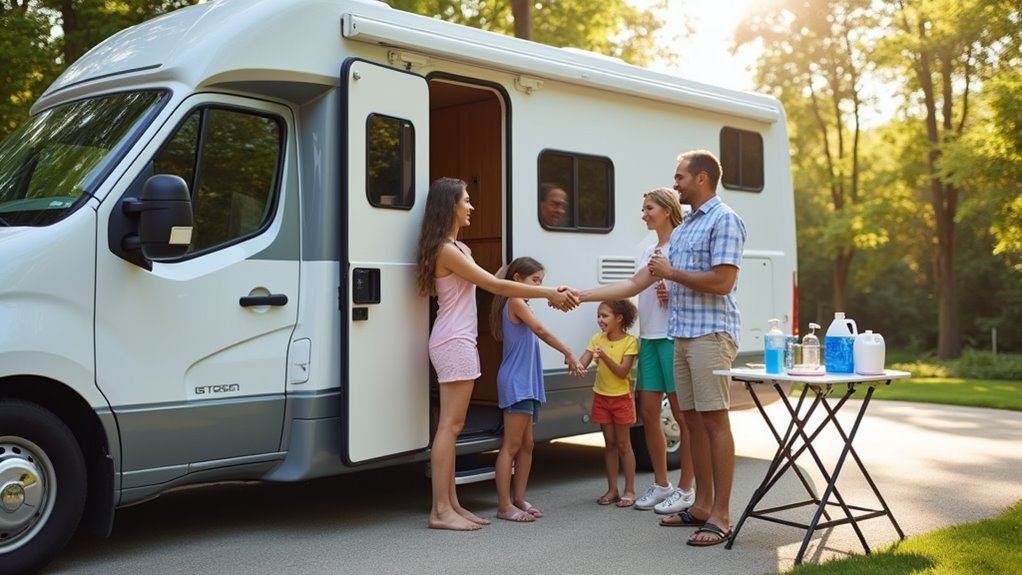
Profit from your parked RV by transforming it into a lucrative rental business—discover the essential steps and insider secrets today.
Have you ever wondered how your RV could transform from a seasonal adventure companion into a steady source of income? You’re not alone. More and more RV owners are discovering the lucrative potential of renting out their vehicles when they’re not using them. Whether you’ve got a Class A motorhome or a compact travel trailer, you’ll find there’s growing demand in today’s sharing economy. Let’s explore how you can turn your idle RV into a profitable venture.
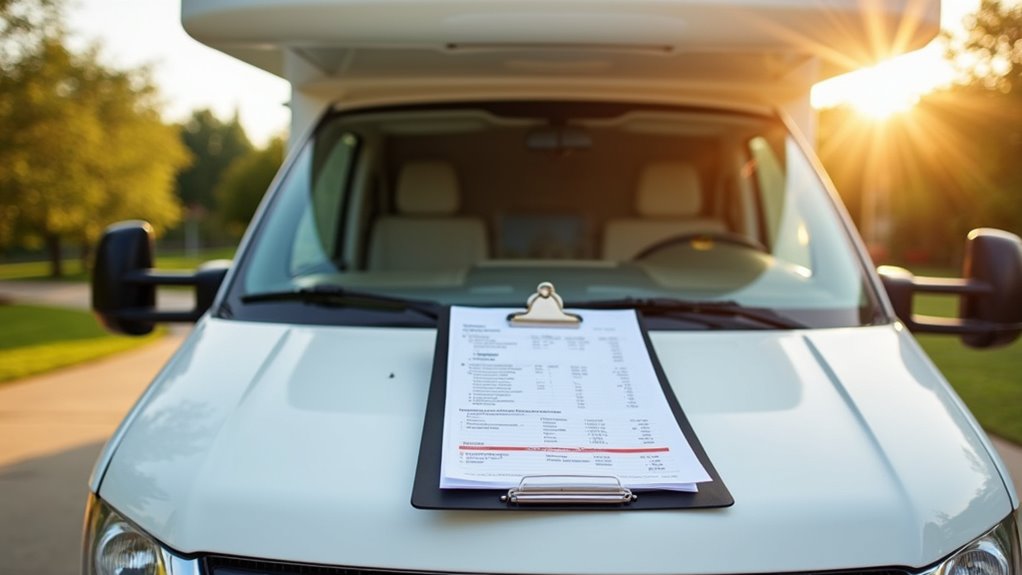
Before diving into the RV rental business, you’ll need to evaluate whether your vehicle has genuine potential in today’s growing market. With global RV rentals projected to reach $1.29 billion by 2030, your success depends on several key factors.
First, assess your RV’s condition, size, and amenities against current market demands. Today’s renters often seek vehicles that accommodate remote work, pet travel, and family activities. The rise of peer-to-peer RV rentals has created more opportunities for individual owners to enter the market. Setting up a passive income stream through RV rentals can provide substantial returns on your investment.
Modern RV renters want more than just a camping experience – they need flexible spaces that work for both business and leisure.
Your location matters too – proximity to popular outdoor destinations or sports venues can greatly enhance your rental potential.
Consider your competition by researching local RV rental offerings and their pricing strategies. You’ll also want to make sure your vehicle meets the requirements of popular rental platforms like RVshare, which can expand your reach and provide essential services like insurance and customer verification.
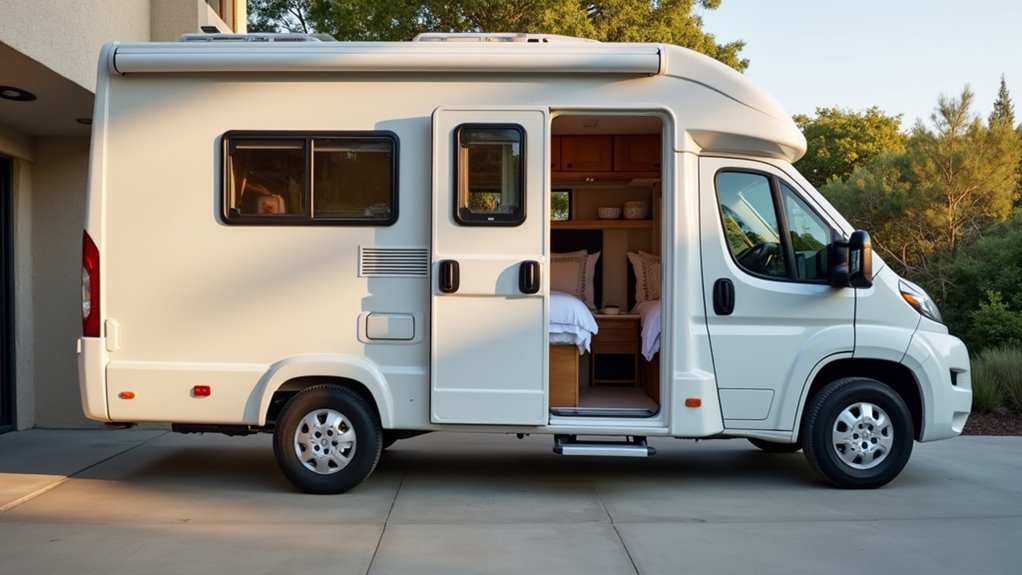
Getting your RV rental-ready requires a thorough approach that goes beyond basic cleaning and maintenance.
You’ll need to start with careful mechanical servicing, including engine checks, transmission updates, and brake system inspections. Creating a detailed rental checklist helps ensure you don’t miss any critical maintenance steps. Don’t forget to replace essential filters and verify the electrical systems.
Next, deep clean and sanitize every surface, paying special attention to the kitchen and bathroom areas. Properly demonstrate how to operate all kitchen appliances during the rental walkthrough.
Stock your RV with basic supplies and essential tools while confirming all appliances work properly. Install and test safety equipment like fire extinguishers and carbon monoxide detectors.
Before each rental, prepare detailed documentation, including pre-trip photos and rental agreements.
You’ll want to schedule enough time for a detailed walkthrough with your renter. This preparation guarantees a smooth rental experience and helps protect your investment.
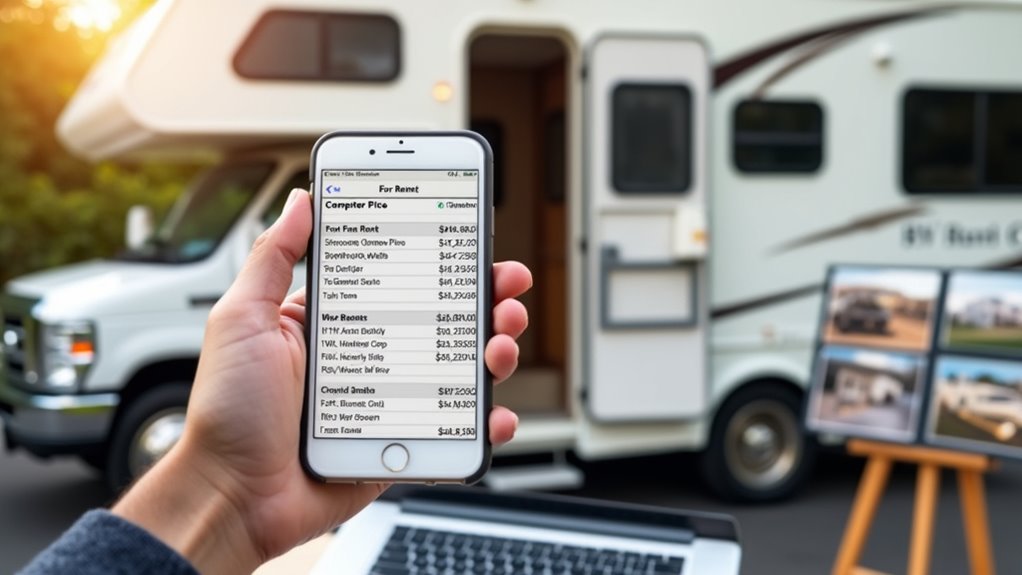
When establishing rental rates for your RV, you’ll need to take into account several key market factors to stay competitive while maintaining profitability.
Current market data shows the average nightly RV rental is $184, with Class A motorhomes commanding $313 and travel trailers at $113.
Consider your RV’s type and size when setting prices. If you’re renting out a Class A motorhome, you can charge premium rates, while pop-up campers should be priced more modestly. With rental prices showing only 4% growth since 2020, the market has demonstrated remarkable stability.
Don’t forget to research your local market, as rates vary greatly by region and season. Looking for budget-friendly alternatives can help you understand what renters are seeking in your area.
Factor in additional costs like insurance, maintenance, and cleaning fees. You might want to offer weekly discounts or off-season rates to attract more renters.
The key is finding the sweet spot between competitive pricing and profitable operations.

Choosing the right rental platform can make or break your RV rental business success. With top players like RVshare, Outdoorsy, and RVezy competing in the market, you’ll want to carefully evaluate your options.
Consider platforms that offer strong renter protection, clear fee structures, and excellent customer support to maximize your earning potential. The market’s rapid 8.11% annual growth indicates strong potential for RV rental businesses through established platforms.
Outdoorsy and RVshare are currently the two largest platforms competing for market share in the peer-to-peer RV rental space.
Remember to compare customer service quality and emergency support offerings, as these features will be vital when issues arise during rentals.
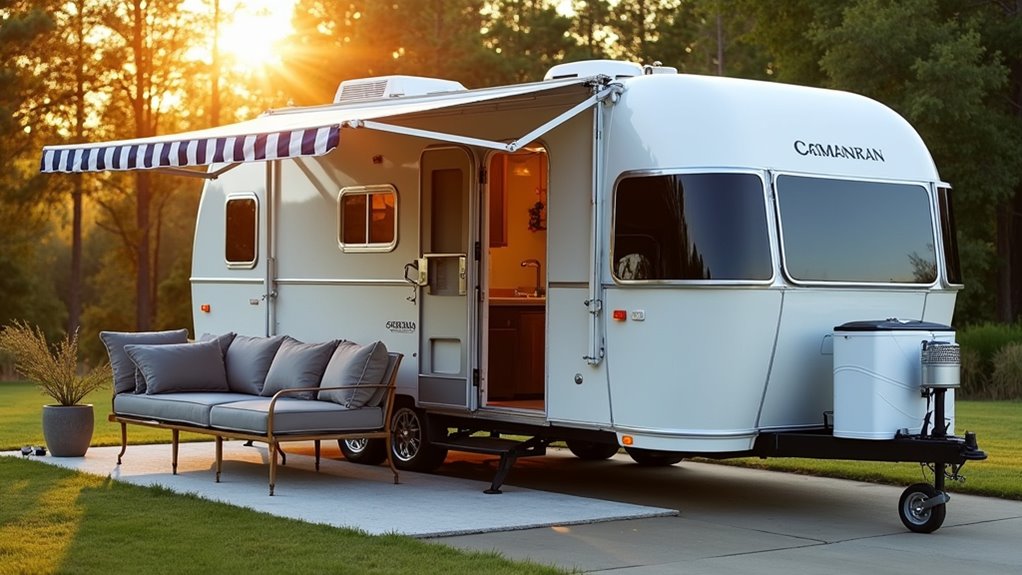
Creating an attractive listing profile stands as your virtual storefront in the RV rental marketplace. Start by crafting a title that includes your location and key features, like “Pet-Friendly RV near Phoenix – Sleeps 6 with Solar.”
Your description should open with a compelling headline followed by essential details about sleeping arrangements, amenities, and included items. Ensuring your first two sentences act as supporting content helps search engines better understand your listing’s relevance.
Take high-quality photos in good lighting, showing both interior and exterior spaces clearly. Don’t forget to capture all sleeping areas, kitchen functionality, and bathroom facilities.
Set competitive prices based on local market research, but be transparent about additional fees and special offers.
Remember to actively seek reviews from satisfied renters and respond promptly to all feedback.
Keep your listing current by updating photos and descriptions to reflect your RV’s actual condition.

Protecting yourself and your RV with proper insurance coverage is vital before entering the rental market.
Securing appropriate insurance coverage isn’t just smart business – it’s essential protection for your RV investment in the rental market.
You’ll need specific rental insurance since personal RV policies typically don’t cover commercial use. Most rental platforms offer tiered insurance packages with varying liability limits and deductibles, often bundled into daily rental rates. Expect insurance costs to range from $15 to $30 per day when renting out your RV.

When you’re ready to rent out your RV, well-crafted rental policies and agreements will serve as your foundation for successful transactions.
Start by clearly documenting the basics: names and contact information of all parties, detailed RV description, rental duration, and pricing terms.
Your agreement should outline specific rules about age requirements, driving restrictions, and occupancy limits. The maximum allowed capacity should be explicitly stated as no more than 6 occupants.
Don’t forget to address pet policies and strictly prohibit smoking.
Include thorough details about your security deposit, including collection, inspection procedures, and refund timeline.
Make certain you’re clear about maintenance expectations and return conditions.
Specify that renters must return your RV clean, with full tanks, and on time.
Finally, protect yourself by including termination clauses, dispute resolution procedures, and proper signature requirements.
Always verify both parties sign and date the agreement.
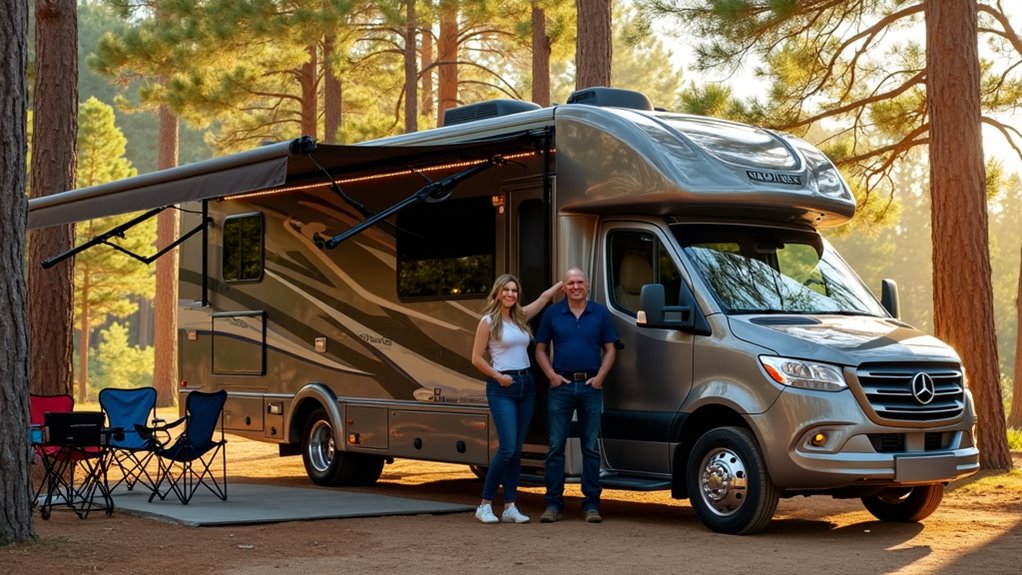
With your rental policies in place, it’s time to get your RV in front of potential renters. Maximize your visibility by listing your RV on popular platforms like Outdoorsy and RVshare, where thousands of renters search daily. Consider targeting Millennials and Gen Zers, as they represent a growing segment of RV travelers. Peer-to-peer platforms make it easy to connect with verified renters looking for unique RV experiences.
Create compelling listings with high-quality photos, detailed descriptions, and competitive pricing. Don’t forget to highlight what makes your RV special, whether it’s luxury amenities, pet-friendly features, or proximity to popular destinations.

Successful RV rental operations depend on establishing efficient day-to-day management systems.
You’ll need to develop thorough user manuals that guide renters through essential operations and safety procedures. A comprehensive Daily Use Manual comes in handy for rental managers to streamline daily operations. Conduct meticulous walkthroughs before each rental to familiarize customers with your RV’s features and systems.
Create digital guidebooks with interactive maps, local recommendations, and real-time updates to enhance the rental experience. While initial setup takes time, rental income potential can make the effort worthwhile.
Stay on top of scheduling, vehicle preparation, and payment processing to guarantee smooth shifts between rentals. You’ll also want to maintain strong customer support for troubleshooting assistance and establish clear processes for handling security deposits and disputes.
Don’t forget to secure proper insurance coverage and stay compliant with local regulations – these elements are vital for protecting your rental business.
Just like turning a hidden gem into a treasure chest, renting out your RV can transform your unused vehicle into a profitable venture. You’ve got all the tools to navigate this journey – from prepping your rig to managing bookings. Whether you’re aiming to offset costs or build a rental empire, your RV’s ready to hit the road. Put these strategies into action, and you’ll be steering toward success in no time.